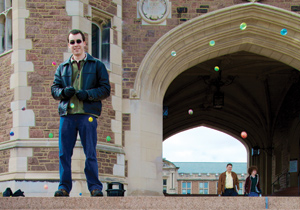 Scott Bressler
Scott BresslerHe can be found in public spaces, greeting strangers and offering a little bit of joy to those who will lend him an ear. However, sophomore Morgan Grossman-McKee is no preacher, politician or philosopher-he gives out bouncy balls.
This math and economics double major simply believes “life is not random enough” and says he enjoys handing out roughly one-inch-wide, brightly-colored spheres of pure fun.
In carrying out his mission, Grossman-McKee has resurrected a vending-machine favorite for many a stranger and University student, in all its childhood glory.
Apparently the rules for enjoying the childhood staple change as an adult. No toy withdrawal or sibling rivalry is necessary to enjoy a good bouncy ball. For enthusiasts like Grossman-McKee, they are available on the Internet, in every color and style.
In 10th grade he realized he could get the balls on the Internet and increase his childhood bouncy ball collection exponentially. But his excitement for thousand-ball bags, at only 10 cents a ball, left him with more rubber trinkets than a single person can do anything with.
So he set out to share his childhood love with others. He hit the streets and passed them out to individuals, families and anybody who didn’t seem too frightened.
“It helps to give to groups; they are less intimidated-it can be a less threatening situation,” said Grossman-McKee.
He even used his collection for intellectual purposes in a high school senior project on the physics of the bouncy ball.
It is easier to pass them out at the University than at home, he conceded, because people here know he is a student and not a random man wandering around.
Last year he handed out bouncy balls at Ursa’s on Wednesday nights, but because he lives off campus now, Olin Library and Hilltop Café have become his target areas.
“Ursa’s was better because people were hanging out instead of working,” said Grossman-McKee. In the library, he explained, people are not usually in the mood for a silly toy.
Most people think he is observing them and recording data about how they react to him. While this is far from the truth, Grossman-McKee is sympathetic.
“You expect that if you give something, you want something in return,” said Grossman-McKee. But people need not be afraid of him: He advises people to consider his actions as “purely rational.”
Rather, one should think “this kid derives some kind of happiness from doing this, so there he goes.” He surely expects others will enjoy bouncy balls too, but does not take his analysis far.
“I hope it makes other people happy too, but there’s nothing deep going on. I have very low expectations,” he said.
Grossman-McKee said he wants students who see him around campus to consider him an uninterested party. Students are free to take or leave any one of his frosty or smiley-face bouncy balls.
Anyone who remembers the days when nothing was sweeter than a gigantic bounce past the parents will appreciate Grossman-McKee’s attempt to recreate such youthful excitement. For the more interested, he has plenty of advice ranging from how to encase a bouncy ball in dry ice to the best kinds of bounces.
“My dream is to replicate the Sony Bravia commercial,” said Grossman-McKee. The commercial is titled “Balls,” and films millions of bouncy balls shot from air cannons bounding down a hilly San Francisco street.
If this dream is realized, Grossman-McKee will pursue a new bouncy-ball project in the future. If that project outdoes giving bouncy-balls away by the handful, Grossman-McKee might one day be recruiting other bouncy ball fans in Hilltop or Olin Library.
 Scott Bressler
Scott Bressler Scott Bressler
Scott Bressler